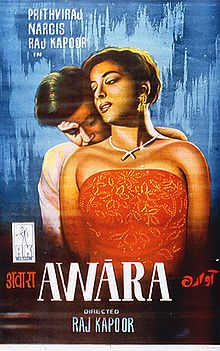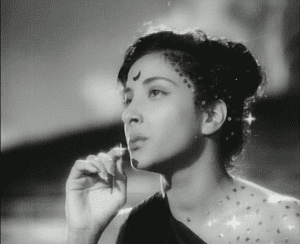On what would turn out to be the eve of the death of the recent gang rape victim in Delhi, my family and I gathered together to watch a Hindi film that my parents had ordered on Netflix. The 1951 movie, Awaara, which translates to “tramp” in English, was produced, directed, and starred in by the early champion of Bollywood films Raj Kapoor and featured Nargis, the most famous leading lady of that time. I was feeling feverish so I was huddled under the brand new Slanket I had presented to my father for Christmas. We’re all Hindus but our Christmas tree stood twinkling in the corner of the room.
The black and white film opens with a courthouse scene where the accused, Raj (Raj Kapoor) is a young man who tried to kill a highly respected judge, Raghunath. When the judge presiding over the case asks who is defending the accused, a female attorney, Rita (Nargis) makes a dramatic entrance just in the nick of time and declares that she is here to mount a defense, while looking over at Raj with loving eyes. She begins to cross-examine Raghunath by asking him if he had any children to which he replies he doesn’t. She presses him and asks if he denies abandoning his wife and child many years ago. And then we are treated to a flashback in which all is revealed and explained.
The theme of the movie, which is taken up by the villains and heroes alike, is this: If you’re the child of a bandit, are you destined to a life of criminality? Or put more broadly, does where you are born determine your destiny? But I was less interested in this question of nature versus nurture. Instead, I found myself more preoccupied by another theme contained in the film’s plot, which in my mind was reminiscent of both the Ramayana, one of the most revered ancient Hindu texts, as well as the recent gang rape in Delhi.
The flashback showed how Raghunath, a young judge, bucked tradition by marrying a widow, Leela. This was almost unheard of given that even in the early part of this century, there were still those who called for Hindu widows to be burned alive on the funeral pyres of their husbands because what life is there for them once their husbands are dead?
 But then one night, Leela is kidnapped by Jagga, an infamous bandit. It turns out that Jagga specifically planned to kidnap Leela as a vendetta because he claimed Raghunath had wrongly thrown him in jail for an alleged rape based on a determination that as the son and grandson of career criminals, he must be guilty. Jagga plans to rape Leela, as retribution but doesn’t when he learns that she is in the early stages of pregnancy. He returns Leela to Raghunath knowing that by kidnapping her he has “tainted” her and that will bring ruin to not only her but also to Raghunath and his unborn child.
But then one night, Leela is kidnapped by Jagga, an infamous bandit. It turns out that Jagga specifically planned to kidnap Leela as a vendetta because he claimed Raghunath had wrongly thrown him in jail for an alleged rape based on a determination that as the son and grandson of career criminals, he must be guilty. Jagga plans to rape Leela, as retribution but doesn’t when he learns that she is in the early stages of pregnancy. He returns Leela to Raghunath knowing that by kidnapping her he has “tainted” her and that will bring ruin to not only her but also to Raghunath and his unborn child.
Raghunath, at first is thrilled to see Leela however, their happy reunion is soon marred because his elder sister tells him that “everyone” is talking about how Leela has brought shame to their house by being with another man. She insists that Leela and her unborn child should be thrown out before they bring further shame to the family name. Raghunath, an educated and powerful man, succumbs to this barbaric thinking and just as Rama casts away Sita for the sake of propriety, in the epic Ramayana, Raghunath abandons Leela and his unborn child. The movie follows Raj, their child as he grows up in a Bombay slum, depicting how he gets pulled into a life of crime by Jagga, the bandit, himself. Kapoor lifted the persona and antics of his tramp from the master tramp, Charlie Chaplin, and set it to Hindi music.
I eventually gave up on the movie because I was feeling increasingly lousy – it turned out I had a 24-hour stomach bug. Anyways, I was pretty sure by this point that through a dramatic twist worthy of a telenovela, the accused, Raj, would be revealed to be none other than the judge’s own abandoned son. But I remained hung up on the plight of the judge’s wife, Leela – how she was devalued and “thrown away” by her husband and society despite the fact that she was the victim. And I thought to myself, are things that different more than 60 years later? In the U.S., we have male politicians putting forth arguments about “legitimate rape.” And in India we have male politicians denigrating female protesters of a brutal gang rape as “painted” and “dented” women.
India is the world’s most populous democracy but it’s also by some measures the worst country for women, despite the fact that it was led by a female Prime Minister for many years. Bollywood, India’s Hindi film industry is known the world over because it makes more movies than Hollywood, but very few of these movies actually move the genre forward. Through its mastery of science and technology, India is on a path to economic and political power but that path will prove illusory if it doesn’t take concrete steps to address the very real systemic issues it faces in terms of women’s rights, poverty, and corruption. Meanwhile, here in the U.S., as we recover from our own wounds from gun violence, hopefully the painful echoes of the protests in India over this horrific crime will rouse us and keep us ever-vigilant of those who seek to condone sexual violence against women or curtail women’s rights.
 I am encouraged because over the last few weeks in India, women and men have turned out by the thousands for vigils to honor the victim and for protests to demand better law enforcement and justice for rape cases. Here in the U.S., voters “kicked out” congressional members who had backwards views on women’s reproductive rights. This makes me hopeful that despite the fact that democracies are messy and don’t in and of themselves guarantee equal rights to all their citizens, it gives its citizens the chance, even if it is a narrow one, at times, to call for justice and be heard.
I am encouraged because over the last few weeks in India, women and men have turned out by the thousands for vigils to honor the victim and for protests to demand better law enforcement and justice for rape cases. Here in the U.S., voters “kicked out” congressional members who had backwards views on women’s reproductive rights. This makes me hopeful that despite the fact that democracies are messy and don’t in and of themselves guarantee equal rights to all their citizens, it gives its citizens the chance, even if it is a narrow one, at times, to call for justice and be heard.
Awaara, which was nominated for the Grand Prize at the Cannes Film Festival, avoided the conventional formula for Bollywood films that persists to this day, which requires a shining hero to rescue a beautiful damsel in distress from an ominous villain. Instead, in Awaara, some heroes emerge as villains, such as Raghunath, the illustrious judge, who let social pressure and backwards thinking cloud over his rationality. Meanwhile, some villains are revealed to have heroic traits, such as the judge’s son, Raj, who came up as a tramp but is redeemed by the power of love. Similarly, women are portrayed as both the oppressor and the savior, with the judge’s sister seeking to leave her pregnant sister-in-law destitute while Rita, the female attorney comes to the rescue of Raj, the lovable tramp. In my mind, the more than sixty-year-old film serves as a cross-cultural time capsule showing how women’s lives played out on the black and white screens of yesteryears. Now we need to figure out how they will play out on the high-definition, three-dimensional, screens of tomorrow.




